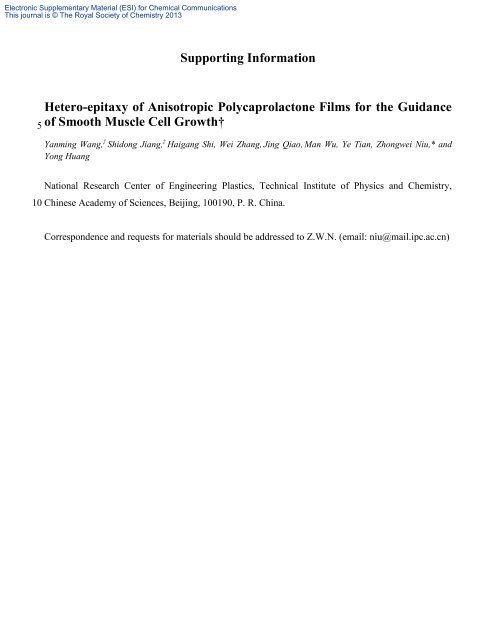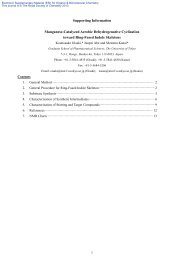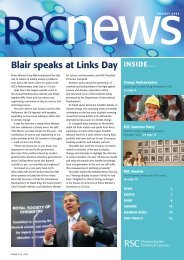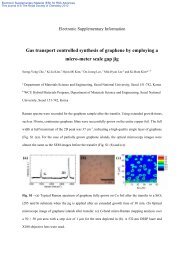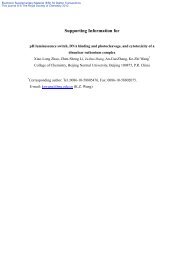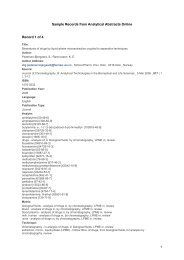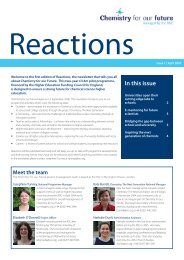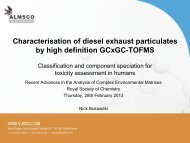Supporting Information Hetero-epitaxy of Anisotropic ...
Supporting Information Hetero-epitaxy of Anisotropic ...
Supporting Information Hetero-epitaxy of Anisotropic ...
Create successful ePaper yourself
Turn your PDF publications into a flip-book with our unique Google optimized e-Paper software.
Electronic Supplementary Material (ESI) for Chemical Communications<br />
This journal is © The Royal Society <strong>of</strong> Chemistry 2013<br />
<strong>Supporting</strong> <strong>Information</strong><br />
<strong>Hetero</strong>-<strong>epitaxy</strong> <strong>of</strong> <strong>Anisotropic</strong> Polycaprolactone Films for the Guidance<br />
5 <strong>of</strong> Smooth Muscle Cell Growth†<br />
Yanming Wang, ‡ Shidong Jiang, ‡ Haigang Shi, Wei Zhang, Jing Qiao, Man Wu, Ye Tian, Zhongwei Niu,* and<br />
Yong Huang<br />
National Research Center <strong>of</strong> Engineering Plastics, Technical Institute <strong>of</strong> Physics and Chemistry,<br />
10 Chinese Academy <strong>of</strong> Sciences, Beijing, 100190, P. R. China.<br />
Correspondence and requests for materials should be addressed to Z.W.N. (email: niu@mail.ipc.ac.cn)
Electronic Supplementary Material (ESI) for Chemical Communications<br />
This journal is © The Royal Society <strong>of</strong> Chemistry 2013<br />
Experimental details<br />
Materials<br />
Polycaprolactone (PCL, M n 70 000 ~ 90 000 g mol -1 ) was obtained from Sigma-Aldrich (Shanghai)<br />
Trading Company. Chlor<strong>of</strong>orm was purchased from Beijing Chemical Works, which was purified by<br />
5 molecular sieve dehydration before use. Other organic reagents, glass plates and glass tubes were<br />
bought from Beijing Chemical Works.<br />
Fabrication <strong>of</strong> composite PCL/PTFE films<br />
The glass plates or glass tubes were first successively cleaned with pure water, hot acetone, hot<br />
concentrated sulfuric acid-hydrogen peroxide solution (concentrated sulfuric acid/hydrogen peroxide =<br />
10 2:1), pure water, and pure ethanol.<br />
To prepare well aligned thin films <strong>of</strong> highly aligned PTFE, the friction-deposition technique was<br />
utilized. Before rubbing, the friction surface <strong>of</strong> PTFE rod was fully polished by 1200 mesh sand paper.<br />
To rub a glass plate, a PTFE rod with the diameter <strong>of</strong> 20 mm and the length <strong>of</strong> 5 cm was used. The<br />
deposition was performed at a velocity <strong>of</strong> 10 mm/s, a temperature <strong>of</strong> 280 °C, and an applied pressure<br />
15 <strong>of</strong> 0.5 MPa. To rub a glass tube (diameter 8 mm, length 4 cm), the home-made PTFE rod (a quarter <strong>of</strong><br />
PTFE rod with the length 8 cm) with the same curvature radius <strong>of</strong> 8 mm as the glass tube was used.<br />
The rubbing was performed at a velocity <strong>of</strong> 10 mm/s, a temperature <strong>of</strong> 280 °C, and an applied pressure<br />
<strong>of</strong> around 0.5 MPa with the home-made PTFE rod at a tilt angle <strong>of</strong> 2º. It should be noted that the<br />
temperature and pressure could not be controlled as well as on flat surface when rubbing inside the<br />
20 tube. After self-cooling into room temperature, the glass substrates or glass tubes with aligned PTFE<br />
were immersed into the PCL solution (about 0.01 g mL -1 in chlor<strong>of</strong>orm) for 1 minute and then pulled<br />
out. After evaporation <strong>of</strong> solvent, the thin anisotropic PCL films were formed on the oriented PTFE
Electronic Supplementary Material (ESI) for Chemical Communications<br />
This journal is © The Royal Society <strong>of</strong> Chemistry 2013<br />
surface. The composite PCL/PTFE films were then further annealed at 55 °C for 2 hours to improve<br />
the epitaxial crystallinity <strong>of</strong> the PCL.<br />
Cell Culture<br />
The glass slides with composite PCL/PTFE films were cut into rectangular pieces with size <strong>of</strong> 1cm × 1<br />
5 cm, and sterilized by exposing to UV light for 1 hour in a clean hood. The glass tubes were cut into 1<br />
cm in length for easy cell culture. The distance between the UV source and the samples was 30 cm.<br />
The samples were placed at the bottom <strong>of</strong> 12-well cell-culture plate followed by being soaked<br />
incomplete medium (high Glucose DMEM (Hyclone) supplemented with 10% calf serum (Gibco) and<br />
1% <strong>of</strong> penicillin and streptomycin sulphate (Solarbio)) for 24 h. Fibroblast-like L929 cells (mouse<br />
10 fibroblast cell line), rabbit vessel smooth muscle cells (SMCs), bone marrow mesenchymal stem cells<br />
(BMMSCs) and Chinese hamster ovary cells (CHO), all obtained from Cell Resource Center (IBMS,<br />
CAMS/PUMC), were cultured on different substrates in cell-culture plate. Cells were seeded on the<br />
samples after the fresh medium being changed, and incubated at 37 °C in the atmosphere <strong>of</strong> 5% CO 2<br />
overnight. Fresh medium was replenished according to the color indicator in all cultures.<br />
15 Cell alignment statistical method<br />
The percentage <strong>of</strong> cell alignment <strong>of</strong> SMCs cultured on composite PCL/PTFE films was statistically<br />
measured. The angle between the long axis <strong>of</strong> a cell and the direction <strong>of</strong> the rubbing was defined as the<br />
cell orientation angle. The rubbing direction was set as 0 o . About 300 <strong>of</strong> SMCs fixed after 3 days’<br />
culturing were measured against the orientation angle. The cells were considered to be aligned with the<br />
20 substrate patterns when the cell orientation angle was less than 15 o .<br />
Real-time polymerase chain reaction (PCR)<br />
The SMCs were seeded on various substrates (composite PCL/PTFE films as the experiment group,<br />
and pure PCL films as the contrast group) and cultured for 2, 5, 7 days respectively. The total RNA
Electronic Supplementary Material (ESI) for Chemical Communications<br />
This journal is © The Royal Society <strong>of</strong> Chemistry 2013<br />
was extracted with Trizol (Invitrogen, USA). Total RNA was converted to cDNA using the<br />
PrimeScript ® RT reagent kit (TaKaRa, Japan). In order to evaluate the gene expression <strong>of</strong> the alpha<br />
smooth muscle actin (α-SMA) and osteopontin (OPN), the Real-time PCR reactions were performed<br />
using SYBR ® Green assay (TaKaRa, Japan) on the Fast 7500 ® Real-time PCR System (ABI, USA).<br />
5 Glyceraldehyde-3-phosphate dehydrogenase (GAPDH), as a housekeeping gene, was used as<br />
endogenous normalization controls for protein-encoding genes. The primers are listed in Table 1.<br />
Table 1.The primer sequences used in the experiment were as follows. Note: all primers are the same<br />
for rabbit vessel SMCs.<br />
Genes Forward Primer Sequence (5’-3’) Reverse Primer Sequence (5’-3’)<br />
α-SMA TGTACCCTGGCATTGCTGACCG TGTGGGCTAGAAACAGAGCAGGG<br />
OPN CCACACGCCGACCAAGGAACAA AGCTGCCCGAATCAGCGTGT<br />
GAPDH CTTCAACAGTGCCACCCACTCCTCT TGAGGTCCACCACCCTGTTGCTGT<br />
10
Electronic Supplementary Material (ESI) for Chemical Communications<br />
This journal is © The Royal Society <strong>of</strong> Chemistry 2013<br />
Characterizations<br />
Morphology detections<br />
Tapping mode atomic force microscopy (AFM) images were obtained at ambient conditions using a<br />
5 Bruker, Multimode 8 AFM. Si tip with a resonance frequency <strong>of</strong> approximately 300 kHz, a spring<br />
constant <strong>of</strong> about 40 N m -1 , and a scan rate <strong>of</strong> 0.8 Hz was used. The orientation <strong>of</strong> the samples was<br />
investigated by polarized optical microscope (POM, Olympus BH-2). The morphology <strong>of</strong> samples<br />
after sputter-coated with gold palladium for 60 s were characterized using a JEOL S-4300 field<br />
emission scanning electron microscope (FE-SEM) operated at an accelerating voltage <strong>of</strong> 10 kV.<br />
10 Fluorescence staining and imaging<br />
Samples were washed twice (10 min per time) with 0.1 M sterilized phosphate buffered saline (pH 7.2,<br />
PBS) at room temperature, followed by being fixed in 4% paraformaldehyde for 30 min, and washed<br />
three times with PBS. Then, the α-actin <strong>of</strong> cells was stained with FITC-Phalloidin (Sigma-Aldrich) and<br />
incubated for 1 h, and the nucleus was stained with DAPI (Sigma-Aldrich) for 10 min. Samples were<br />
15 thoroughly washed three times with PBS, and the glycerol/PBS mounting medium was added to the<br />
samples before inspection with fluorescence microscope (Observer D1, Carl Zeiss). All the microscope<br />
settings were the same, in which the exposure time was 245 ms.
Electronic Supplementary Material (ESI) for Chemical Communications<br />
This journal is © The Royal Society <strong>of</strong> Chemistry 2013<br />
Figures<br />
Figure S1. AFM phase (a, b) and height (c, d) images <strong>of</strong> (left) friction-transferred single PTFE layer<br />
and (right) composite PCL/PTFE films on glass substrate, and their corresponding cross-section<br />
5 pr<strong>of</strong>iles (e, f), respectively. SEM images <strong>of</strong> single friction-transferred PTFE layer (g) and composite<br />
PCL/PTFE films on glass substrate (h). The arrows indicate the sliding direction <strong>of</strong> PTFE on glass<br />
substrate.
Electronic Supplementary Material (ESI) for Chemical Communications<br />
This journal is © The Royal Society <strong>of</strong> Chemistry 2013<br />
5 Figure S2. POM images <strong>of</strong> the sample under crossed polarizers, the anticlockwise ratation angle to the<br />
beam axis in which is 0° (a) and 45° (b), respectively. The white dashed line indicates the boundary.<br />
Top part is the PCL crystallized on glass substrate (pure PCL films) and bottom part is the PCL<br />
crystallized on the PTFE surface (composite PCL/PTFE films). The arrows indicate the rubbing<br />
direction.<br />
10
Electronic Supplementary Material (ESI) for Chemical Communications<br />
This journal is © The Royal Society <strong>of</strong> Chemistry 2013<br />
Large area characterization <strong>of</strong> the PCL/PTFE film<br />
We selected couple areas to perform large (50 μm× 50 μm) area characterization <strong>of</strong> the PCL/PTFE<br />
film by AFM. As shown a typical AFM height image below (Fig S3), the whole film was very<br />
homogenous with surface roughness 8.54 nm and the height difference around 40 nm. These data were<br />
5 added in the revised manuscript. Furthermore, the composite PCL/PTFE film was also checked by the<br />
TEM-EDAX, and the selected area electron diffraction pattern (Fig. S4) also indicates that the whole<br />
film had the highly homogeneous structure.<br />
10um<br />
10 Figure S3. Large scale AFM height image <strong>of</strong> the composite PCL/PTFE film and the corresponding<br />
cross-section pr<strong>of</strong>ile.
Electronic Supplementary Material (ESI) for Chemical Communications<br />
This journal is © The Royal Society <strong>of</strong> Chemistry 2013<br />
(0014) PCL<br />
(0013) PTFE<br />
Figure S4. Selected area electron diffraction pattern <strong>of</strong> the composite PCL/PTFE film.
Electronic Supplementary Material (ESI) for Chemical Communications<br />
This journal is © The Royal Society <strong>of</strong> Chemistry 2013<br />
Isotropic PCL film<br />
The isotropic PCL film on the glass slide with random grown spherulites was employed as the<br />
reference. As shown in Fig. S5, sperulites with diameter around 50 μm are randomly grown on the<br />
glass slide.<br />
a<br />
5<br />
50μm<br />
b<br />
c<br />
10μm<br />
1μm<br />
Figure S5. (a) POM micrograph <strong>of</strong> single PCL film, (b) AFM height image <strong>of</strong> a spherulite on single<br />
PCL film and (b) the zoom-in AFM height image as marked in part (a).<br />
10
Electronic Supplementary Material (ESI) for Chemical Communications<br />
This journal is © The Royal Society <strong>of</strong> Chemistry 2013<br />
Stability test <strong>of</strong> the film<br />
The stability <strong>of</strong> the composite films was tested by treating samples under ultrasonication in PBS for 5<br />
min and incubation in PBS for 2 weeks. As shown in Figure S6b and c, after ultrasonication and<br />
5 incubation, the surface <strong>of</strong> thin film still maintained the similar morphology as untreated sample (Figure<br />
S6a). Furthermore, their corresponding cross-section pr<strong>of</strong>iles (Figure S6d, S6e and S6f) clearly show<br />
only slight difference <strong>of</strong> height <strong>of</strong> treated samples with untreated samples. The surface roughness for<br />
these samples is very similar, which is 8.54 nm for untreated sample, 10.6 nm for ultrasonication<br />
sample, 10.0 nm for incubation sample, respectively. These results illustrate that the composite<br />
10 PCL/PTFE films were very stable in PBS for at least 2 weeks.<br />
a b c<br />
d e f<br />
Figure S6. AFM height images <strong>of</strong> (a) untreated PCL/PTFE thin film, (b) after ultrasonication in PBS<br />
for 5 min and (c) after incubation in PBS for 2 weeks. (d), (e) and (f) are corresponding cross section<br />
15 pr<strong>of</strong>iles <strong>of</strong> (a), (b) and (c).
Electronic Supplementary Material (ESI) for Chemical Communications<br />
This journal is © The Royal Society <strong>of</strong> Chemistry 2013<br />
Rubbing the glass tube<br />
As shown in the Scheme S1, to rub a glass tube, the home-made PTFE rod with the same curvature<br />
radius <strong>of</strong> 8 mm as the glass tube was used. The rubbing was performed manually at a velocity <strong>of</strong> 10<br />
mm/s, a temperature <strong>of</strong> 280 °C, and an applied pressure <strong>of</strong> around 0.5 MPa with the home-made PTFE<br />
5 rod at a tilt angle <strong>of</strong> 2º. It should be noted that the temperature and pressure could not be controlled as<br />
well as on flat surface when rubbing inside the tube.<br />
Scheme S1. Schematic illustration <strong>of</strong> rubbing the glass tube by a PTFE rod.<br />
10
Electronic Supplementary Material (ESI) for Chemical Communications<br />
This journal is © The Royal Society <strong>of</strong> Chemistry 2013<br />
Figure S7. The FM merged images <strong>of</strong> various cells on composite PCL/PTFE films. (a) L929 cells<br />
were cultured for 3 days. (b) BMMSCs were cultured for 7 days. (c) CHO cells were cultured on<br />
5 curved composite PCL/PTFE films for 7 days. Arrows indicate the PTFE rubbing direction.


